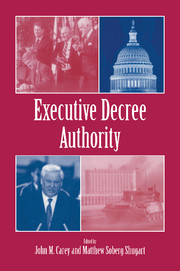Book contents
- Frontmatter
- Contents
- List of Contributors
- Preface
- 1 Calling Out the Tanks or Filling Out the Forms?
- Part I From Delegated to Constitutional Decree Authority
- Part II Constitutional Decree Authority and Conflict Between the Branches
- Part III Absence of Conflict Over Decree
- 8 Executive Decree Authority in France
- 9 In Search of the Administrative President: Presidential “Decree” Powers and Policy Implementation in the United States
- 10 Institutional Design and Executive Decree
- Appendix of Constitutional Provisions Regarding Decree
- References
- Index
8 - Executive Decree Authority in France
Published online by Cambridge University Press: 18 December 2009
- Frontmatter
- Contents
- List of Contributors
- Preface
- 1 Calling Out the Tanks or Filling Out the Forms?
- Part I From Delegated to Constitutional Decree Authority
- Part II Constitutional Decree Authority and Conflict Between the Branches
- Part III Absence of Conflict Over Decree
- 8 Executive Decree Authority in France
- 9 In Search of the Administrative President: Presidential “Decree” Powers and Policy Implementation in the United States
- 10 Institutional Design and Executive Decree
- Appendix of Constitutional Provisions Regarding Decree
- References
- Index
Summary
INTRODUCTION
Influenced by the frequent inability of the government to act decisively during the Fourth Republic, Charles de Gaulle and Michel Debré, in crafting the institutional arrangements of the Fifth Republic, sought to create a strong executive, one that could bring efficiency and responsiveness to political decision making in France. To this end, the French Constitution of 1958 creates two executives, a president and a prime minister. For both of these executives, decree authority is an important ingredient in de Gaulle's and Debré's recipe for executive control.
The French president is directly elected by the voters, which gives substantial political authority to the office. In addition the president has the power to dissolve the National Assembly (although this power can be exercised only once a year). Aside from dissolution, however, the president has few institutional means for influencing legislative outcomes: The president has no formal opportunity to propose policies, alter the agenda, or amend policies in Parliament. And in contrast to the United States, the French president cannot veto bills that have been adopted by the legislature.
Article 16 of the Constitution, however, gives the president the right to declare a state of emergency. Upon making such a declaration, the president obtains virtually unlimited power to take measures by decree in response to the emergency. In principle this constitutional decree authority represents one of the most important weapons that the president can use to influence policy outcomes in France.
- Type
- Chapter
- Information
- Executive Decree Authority , pp. 233 - 253Publisher: Cambridge University PressPrint publication year: 1998
- 6
- Cited by



